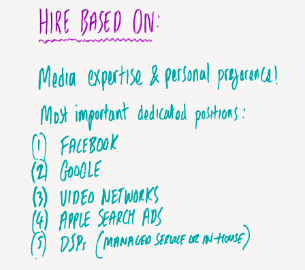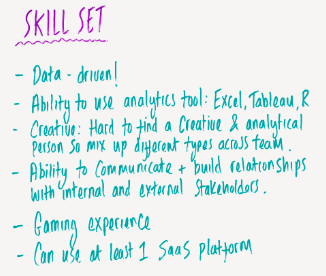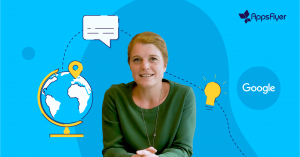
Putting aces in places: Building a UA team for rapid growth
Welcome to the fifth edition of MAMA Boards, an AppsFlyer video project featuring leading mobile marketing experts on camera.
For today’s mini whiteboard master class, we have Saikala Sultanova, Director of User Acquisition at Ubisoft, a leading creator, publisher and distributor of interactive entertainment and services worldwide.
Saikala debunks the common challenges around when, why, and how to build and scale your user acquisition team alongside your company, then offers three of her most powerful tips on harnessing your company’s resources to ensure your dream UA team is aligned with your long-term goals. Goodbye wasted budgets, hello visible user growth!
Real experts, real growth. That’s our motto.
Enjoy!
Transcription
Hey, everyone, welcome to another edition of MAMA Boards by AppsFlyer. My name is Saikala, I work for Ubisoft Mobile Games as Director of User Acquisition.
As you all know, Ubisoft is a big global brand that develops games for both console and mobile, and I look after the mobile side of the business with user acquisition.
With my past experiences working in different gaming companies and building structures and teams, I’ve had different experiences that have helped me to figure out how to build the best team.
When and why should I start scaling my UA team?
So today, we’re going to talk about putting aces in places on how to build a UA team to help you with rapid growth. Everyone’s dilemma in this industry: when and why should we start scaling our UA teams internally?
And it all goes back to the ad spend per month.
I’ve taken an example of, on average, between $300k to $500k per month per person. So if you are spending around this amount of money and you think that you came to the question, “Should I hire more [UA employees] or not?”, the answer is, most of the times, that probably you would need to hire more people.
On the other side, when shouldn’t you hire more people?
If you feel you’re overworked and you’re stretched and there’s a lot of work and you only have one person but the total monthly budget that you spend per month, let’s say it’s not $300k, it’s $50k or $100k. If you feel overworked, you need to trim down and focus on the most impactful networks.
So let’s say, if you run 10 networks with just $50k or $100k a month, that’s too much, that’s not enough, it’s not statistically significant. What this means is that you need to focus on just two or three, or maybe even just one [network], that brings you the best performance overall.
And then going back to the other side, of course, naturally, if you’re reaching this threshold, you should definitely start thinking about when and how you’re going to scale and this is when we are going to fall into the team structure.
On what factor(s) should I base my hiring and team structures?
In various teams in the past, I’ve tried to structure teams in different ways. We’ve tried before per product and then we’ve tried before per network as well. Through my experiences, I understood that the most efficient way would be to structure per network.
Every UA person has favorite network. For myself, back in the day, I could manage about 10 networks, no problem, but of course, I had one or two of my favorites and naturally I spend the most time with them.
Subsequently, if I’m spending more time [with particular networks], that also means I have the best skill in those networks. For this reason, if you structure your team based on skills per network – let’s say this person could be Facebook ninja and that’s all she loves to do all day long. Of course, you would want her to just be responsible for Facebook driving for all of your products, however many there may be.
And let’s say, if this guy is really good at Google – Google UAC, of course – he would know all the tricks and hacks and how to do it at scale in the most impactful way and of course, you would want to [focus his efforts there].
This way, when you have [each team member placed] based on skill, you would also be able to manage different products [with this structure]. If every single person manages a particular network, or a few if they can, and they do it for all of the products that you work with, they can also learn from each other. Let’s say that [three separate games] have different performances on the same network, so learning from the others could alternatively benefit each individual game.
What skill sets does and good UA candidate have?
So, now you have decided that you definitely would like to hire at least one person because you scaled up your ad spend and you know what you want. Now it comes down to, “Who do you hire?” That’s quite a big dilemma for many of us in the industry.
So what we did [at Ubisoft], we developed a short list of skill sets that we look for.
First, [we are looking for a] data-driven approach. It’s very important for all of our candidates to have data-driven approach because, without data, we just don’t work.
Second is the ability to use any of the analytical tools. That could be R, Tableau, anything out there, SQL. It could even be as simple as Excel because those kind of skills are transferrable to any other tool afterwards.
Third, we look for creativity. From past experience, it was always very challenging to find a UA manager with both creative and analytical abilities – it always tends more strongly towards one or the other. With experience and different companies, what I’ve learnt is that it’s important to keep the balance in the team. It’s not possible to find one person with both things and, when building teams, we try to make sure that some part of it is more analytical and some part of it is more creative. That way, they can complement each other and operate with better teamwork going forward.
Fourth, it’s very important that candidates, and also your teammates, are investing time and effort into communications and building relationships with both internal and external stakeholders. With both your ad networks and service providers, the better relationships you build and the more you learn about the products, the better you can leverage this knowledge for your own activity.
The fifth qualification we like candidates to have is relevant experience. Gaming experience is a cherry on the cake for us, so naturally, according to your vertical – whether it’s weather apps, dating apps, FinTech, or anything – you can decide if that’s necessary for you or not. For us, it’s nice to have.
Sixth and last, the candidate should be able to use at least one SaaS tool. It could be anything, it could be Facebook, it could be Google Ads, it could be AppsFlyer. So as long as the person can use at least one SaaS tool, that would be great and it’s a good sign.
How does working with agencies fit into mobile user acquisition?
Another important aspect of user acquisition for mobile is working with agencies.
Many companies ask me, “Should we work with agencies? Should we not? Is it good? Is it not and should we just do everything in house?” Yes, there are questions like that, but if you look at it slightly differently, if you look at it in a way that you can actually get pros that are experienced, that worked with lots of your competitors in the field and actually sometimes could know better [than you], you can learn a lot from them.
You need to make sure that the agency could help you benchmark your own team – how do you know if you kick-ass internally if you don’t benchmark yourself with other pros?
Also, it generates additional bandwidth because, going back to that scale and structure and all of the networks and the kind of skills that we require, it takes time to get people through the door. While it takes time, you still need to continue delivering at scale and this is when agencies could be a really good help for doing that while you’re still hiring.
And then, with some of the really good partners and really good agencies, you can actually learn from them.
I can tell you – I think, when was it? Last week? The week before? – I actually learned something new from our agency and that was a very good, positive experience.
And lastly, if you leverage agencies by treating them as an extension of your own team, not a competition, you can either divide the work equally or not to make sure that you deliver profitable growth. In the end, it is a demonstration of the whole team working together and it should never be considered as a competition – like I said, it’s more of an extension.
However, what we shouldn’t forget is that it’s only worth it if you can afford it. Going back to “hire-or-no-hire,” if you are positioned to hire and the hiring process is still happening and your ad spend is growing quickly, then working with an agency is a good option for you in the meantime. If you are [spending less than $300k – 500k in house and feeling overworked], it’s probably too early for you to work with agencies. You can look at it and consider it for the future, but I don’t recommend working with one yet.
3 user acquisition tips
So, once we figure out all of the team structure and hiring and what we need to do going forward, we then would look at these 3 priorities, these 3 [tips I’ve written on the board here].
First, we can SWOT our existing UA function. Whatever it may be, it could be a team, it could be no team, it could be some activity with an agency within a new company, you need to look at what you have right now and identify strengths, weaknesses, opportunities and threats. Classic.
So in this case, some questions might be, do you have a tech stack? Do you have a data engineer in-house? Is this already sorted out? Because a functional UA team for mobile apps cannot function without it. Also, do you produce creatives internally or is there an agency or some external source that delivers creatives for you? Do you look at LTV, ROI and all the other basic analytics that everyone looks at?
Then we look at what’s missing and what we already have and try to map it into priorities – what you need now, what you need in a mid and long-term plan, etc.
Second tip is prioritizing between overall ROI and global launches. For us in gaming, we think about working with all of these factors of SWOT-ing a UA function but also about working closely with business and finance. We need to understand what is the most profitable for our company and what we should focus on.
Sometimes, we focus on ROI only, which is what’s bringing revenue right now, but sometimes, we also have future projects that are currently in soft launch or are planning to be in soft launch soon. Those kind of projects still get a lot of our time because, strategically, they are important for future growth when we need to prepare for global launches.
Now, going to the third tip, we need to identify the strengths of every team member.
We talked earlier about putting aces in places, but before knowing how to put aces and where to put your aces, in which places, you need to first identify the strengths of every team member.
This might be done per network, preference and skill set, but also, depending on who they are and how much better they run, they may be able to run more than one network, sometimes 2, sometimes 3, sometimes more, and it all goes back, also, to budget size.
So if one person on my team is running only Facebook and already spending $500k or $1M a month, I would not expect them to look after any other network naturally, and so on – it depends on that.
Also, mixing all of these things together would bring us to Creativity & Science because you need your creative; you need your data and engineering and tech stack; and you need to make sure it all goes back to the business goals and aligns with a finance function. This is how we bring profitable growth going forward.
What is the hiring process for companies with good UA teams?
So, you’re probably wondering, what is the hiring process in some companies, or maybe specifically at Ubisoft?
Our normal process is that we find people through networking or LinkedIn posts or anyone who reaches out to us. We also have internal recruiters. After we have a handful of people, there is an interview call to check the skill set match. Then, after that will come the test for gathering actionable insights from raw data. In this test, we release the raw data dump and see how you can analyze it. Last but not least is the face-to-face interview, it’s mainly for culture fit, meeting the team, asking questions, giving a candidate the opportunity to also interview us, because it goes both ways.
The bottom line
In the whole of this process, the bottom line for me is to make sure we stay open-minded and practice continuous learning, because this is the only way forward. The industry is changing so fast, mobile UA is changing every day, and if you stay open-minded and continue learning, this is how we’re going to stay on top of the UA game.
Thanks very much for watching. If you’d like to leave some comments, do that below and if you’d like to watch more MAMA Boards, here is the link.
Bye.







